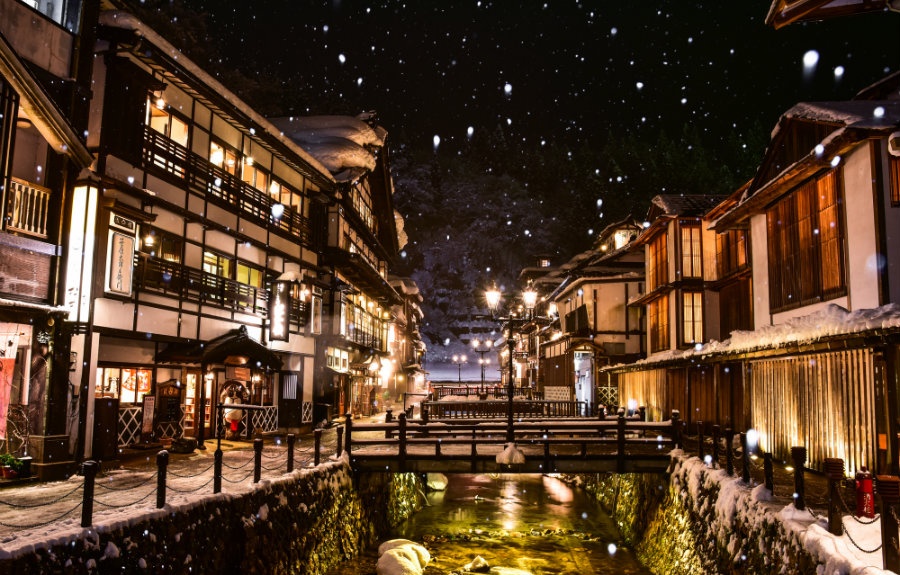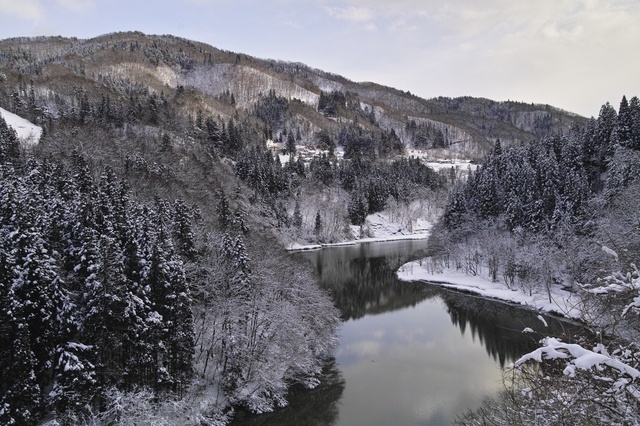Yamagata: Rivers of Ice & Snowy Onsen

Yamagata literally means “mountain shape,” and the prefecture is indeed mountainous: the Dewasanzan, Asahidake and Iidesan mountain ranges ridge her spine, and the storied Mogami River rushes through from the south to the Sea of Japan on the northwest border.
By Highlighting Japanhttps://www.youtube.com/watch?v=40u9VrkLrAE&feature=youtu.be
Fat flakes fall on the sleepy town of Ginzan Onsen (Silver Mountain Hot Springs), a small collection of buildings clustered around a bend of the Ginzan River in Yamagata’s northernmost area. Steam rises from the water, and some of the snowflakes vanish, but most pile up in a thick, muffling blanket on traditional ceramic-tiled roofs. A warm glow emanates from the windows and the smell of sulfur hangs in the mist, an evocative scene reminiscent of Hayao Miyazaki’s movie Spirited Away.
Established in the 1400s as a silver mine, Ginzan Onsen reached its height in the 1600s. After the silver was gone, the population thinned, but the hot springs were still known as a place for therapeutic bathing. The town remains a picturesque hamlet where people enjoy the traditional setting, soothing waters and quiet atmosphere.
At Showakan, one of the ryokan (Japanese inns) in Ginzan Onsen, the toasty and warm tatami-matted rooms come stocked with piping hot green tea and snacks waiting on a low table. Dinner is soon served, bursting with seasonal and local delicacies, including salted, grilled ayu (sweetfish, a small river fish), roasted sansai (mountain greens) wrapped in bamboo leaves and cooked in miso, and beni-gohan, or steamed rice cooked with safflowers, which turns the grains yellow and red.
A plethora of choices is available for visitors planning an after-meal bath. The extremely soft water is said to be especially good for rheumatic conditions and improving skin.
Yamagata is famous for its fruit. Cherries top the list, but the farmers here also grow strawberries, pears, grapes, blueberries and more.
Sagae Green Park offers all-you-can-eat strawberry picking in a country greenhouse. Measuring 1,000 tsubo (a Japanese unit of measurement equivalent to about 4 square yards), the greenhouse is wall-to-wall with plants dotted with sweet white flowers, the heady sweet scent of strawberries in air abuzz with bees. Visitors gleefully consume the bright red berries, cheeks bulging.
Another memorable activity is to ride a boat on the Mogami River to retrace part of famous haiku poet Matsuo Basho’s journey through the region. Called a kotatsubune, this long, flat riverboat holds up to 40 passengers and in the winter has kotatsu, heated tables with thick quilts over the top. Guests sit in cozy comfort while watching the silent, snow-coated banks and ice floes drift by outside. The regular boat tours are available year-round, and outfitted to match the season.




